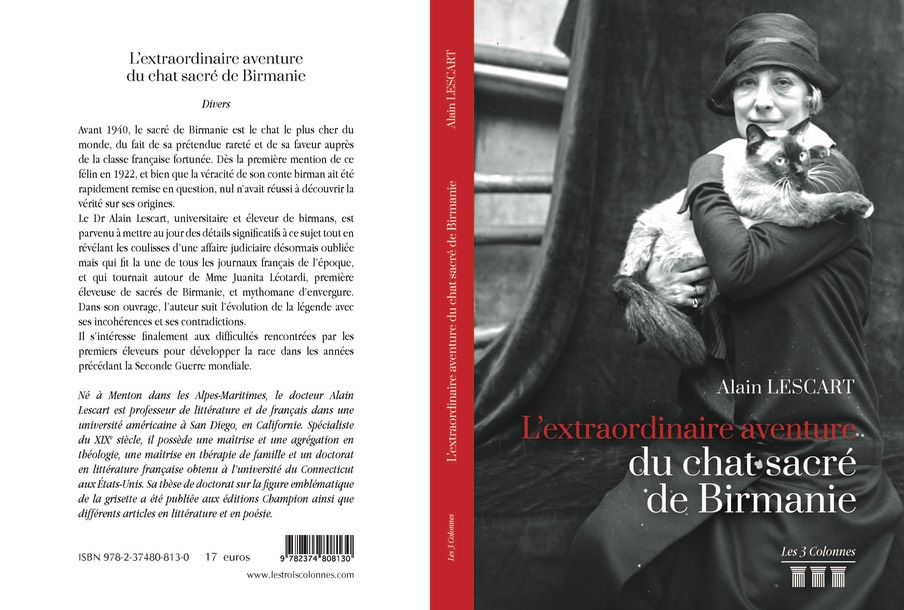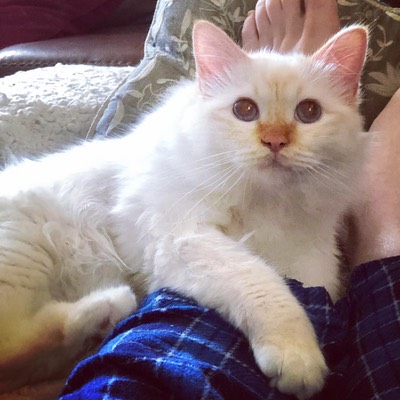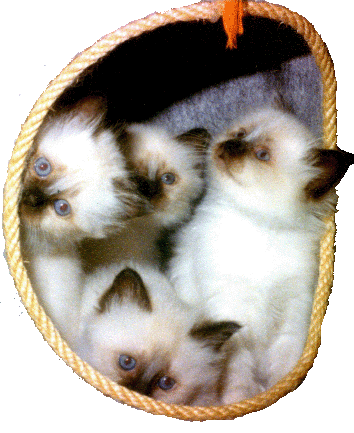My book on the origin of the Birman cat is published in France (in French) and can be bought on amazon in Spetember 2020.

THE ENGLISH VERSION CAN BE ORDERED HERE:
BOOKBABY.COM

The Cat Club de France was created in 1913 by Dr. Jumaud, at Saint-Raphaël.
THE SACRED CAT OF BURMA HISTORY
Circa 1921
One of the first official mention of Le Chat Sacré de Birmanie is found in a small French booklet untitled : "Les races de Chats" by Dr. Ve Ph. Jumaud, in 1925. But its first mention in a newspaper goes back to December 1922.
Dr. Philippe Jumaud, General Secretary of the French Cat Club (Cat Club de France) wrote his dissertation on cats' breeds. He is, in France, one of the first to do that study in a serious way. This book is the work of 20 years of research by Dr Jumaud. The 2 first editions were printed at 3000 copies. This 3rd edition (cf. pic) included some new material and the Birman article (pp. 52-60).
The fabricated legend invented by Mme Juanita Léotardi says that Birman cats originated in Burma where they were kept by temple priests (kittahs) in High Burma mountains. This is a full invented story made up and put in a poetic form by Mme Marcelle Adam (novelist and president of the Federation Feline Française and owner of the Manou of Maldapour). It was first published by Miss Adam in January 1926. The real person behind all the myth and mystery is the first Birman breeder in France, Miss Juanita Leotardi who was also a fabulator and invented all kind of stories to justify an extreme high price for the Birman cat. (Read my book about this).
A more completed version of this tale was then published in the French Review Minerva, in 1927. It presents many historical and factual issues hard to reconcile. The legend borrows from the nearby Siamese cat history (Siamese cats were introduced few decades before in England (1884 by British Consul-General Gould) and in France by Auguste Pavie [as mentioned in his Mission Report – Pavie sent 4 Siamese cats to Paris’s museum in the last decade of the Nineteenth Century).

Birmans owe much to the work of a few breeders of that time like: Mme Leotardi, Mme Marcelle Adams, Mme Brassart, Mr. Baudoin-Crevoisier, Mme Chaumont-Doisy, Mme Simone Poirier. The most famous Birman of that time was Dieu d’Arakhan created by M. Baudoin Crevoisier and sold to Mme la comtesse Giriodi Panissera in 1934. The foundation of the breed in prewar France were offspring of birmans that had to be heavily outcrossed with long-hair breeds (mainly with the new Persans Colourpoint) and also lomg-hair Siamese lines - Balinese- (like Kiou) to rebuild the Birman breed.

Birmans were almost wiped out as a breed during World War II. Only a few cats were alive in Europe at the end of the war in France, a pair named Orloff and Xenia de Kaabaa, both belonging to Mme Boyer. By the early 1950s, pure Birman litters were once again being produced. The restored breed was recognized in Britain in 1965 and by the CFA in the USA, in 1966. The first Birman cats were only seal-point for a long time and the Blue-point color was introduced in 1959 (Iros du Clos Fleuri) using Blue Persan lines (Persan Bluette de la Cote Azure). They owe much to the work of the des Muses Cattery (in the USA one of the first Blue Point was Griswold’s Burman Boi Bleu, born in 1964). New colors were added by the work of English Breeders in the 1970-1980: chocolate and red-point and the tabby/lynx version.
Birmans first arrived in Australia in 1967. “Grand Champion Stacpoly Kharma” and “Praha Shigatse” were imported from UK by Mrs J Starky of Sydney.
A Birman was also used to create new breeds like the Ragdoll cat in California, as indicated in the first CFA Ragdoll pedigree.
We now find also the new Cinnamon and fawn color, creaetd in France and other countries.
Note:
- Since 2008, New-Zealand Birman breeders (Lee Williams & Amanda Stokes) are presenting an experimental short hair version of the cat. They call it the Templecat Shorthair Birman. This new attempted breed was created by mating a cinnamon spotted tabby cat, an Oriental cat, to the Birman.


